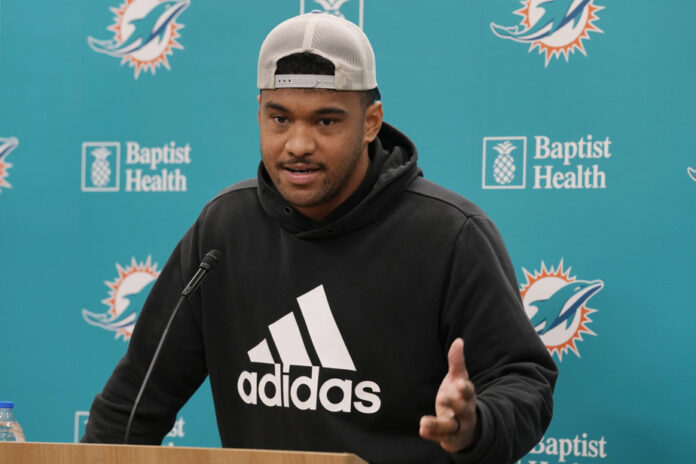Tua Tagovailoa thought about quitting playing football.
The thought came to him, briefly, after he was diagnosed with two concussions last season and many wondered if the 25-year-old Miami Dolphins quarterback could ever return.
But after talking to his family and doctors, Tagovailoa pushed back on the idea of retirement and began training in martial arts to reduce head trauma.
“I’ve always dreamed of playing as long as possible, until my son can understand what I’m doing,” Tagovailoa said Wednesday. It’s my health. It’s my body. And I think that’s the best thing for me and my family. I like football. If not, I would have quit a long time ago. »
Today, Tagovailoa is learning to fall.
Although he’s only just beginning his jiu-jitsu training – he’s a white belt – Tagovailoa is working on ways to land safely while on the field.
“At first we used mats to try and fall down,” he said. Obviously tucking the chin in was one of the things to do. We’ve looked a lot more at the technique of dispersing energy when falling, what posture to adopt and, if you’re not in this posture, what other things you can do to disperse energy during the fall. of the fall. »
Tagovailoa will have to wait until the start of the season to see how his training translates to the pitch, where split-second decision-making during fast-paced play can sometimes be the difference between one injured player and another. who does not get hurt.
“I crashed a lot in the offseason. Like everything else, you have to keep practicing. You keep working and it becomes second nature, Tagovailoa said. When such a situation occurs, it is not something new that presents itself to you. And for the guys in my position, we’re barely touched, if at all, in practices, in the offseason, and even in training camp. We are not affected before the start of the season. »
In a September victory over the Buffalo Bills, Tagovailoa missed the final three plays of Miami’s first half after hitting his head and wobbling a few steps while getting up. He was cleared to return to the game and later said it was the result of a back injury. No concussion was diagnosed as a result of this incident.
Four days later, he was punched again during a game in Cincinnati, then briefly passed out. He was evacuated from the field on a stretcher. As he lay on the grass, his fingers showed what is known as the “closure reaction”, which usually indicates a serious neurological problem. He was then put on concussion protocol.
The Tagovailoa situation prompted rapid and significant changes to concussion protocols from the NFL and the Players Association. The most notable addition was making loss of balance and/or stability a symptom prohibiting a player from returning to play.
Since then, Tagovailoa said he has consulted numerous neurologists who he says do not believe he is more likely to suffer head injuries than any other player in the future, nor is he at greater risk. chronic traumatic encephalopathy (CTE), a brain disease associated with repeated blows to the head.
“It’s only when you’re constantly banging your head on something that you’re at risk for chronic traumatic encephalopathy. I think it’s more about linebackers, offensive and defensive line players, guys who are constantly fighting, Tagovailoa said. It also played a role in my decision making and my desire to come back to play. »















